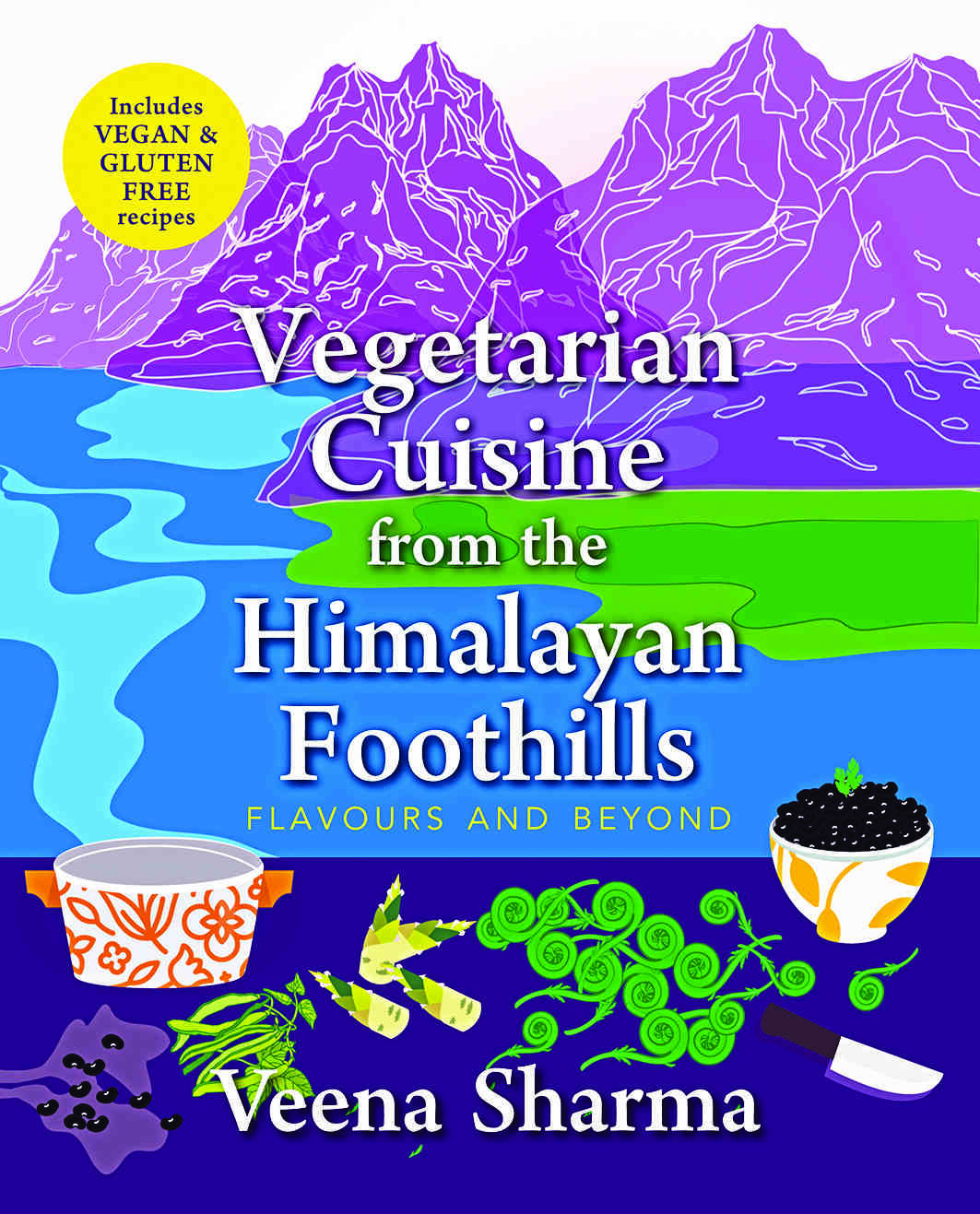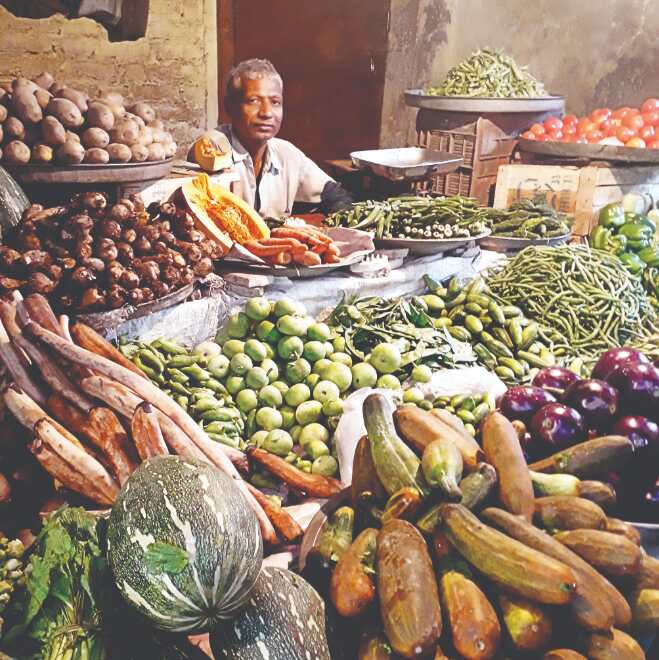"Vegetarian Cuisine from the Himalayan Foothills" | A Culinary Smorgasbord
A delectable experience for gastronomes, Veena Sharma’s Vegetarian Cuisine from the Himalayan Foothills delves into mouth-watering recipes that draw upon local bounties – some forgotten, or less used, grains and greens, spices and fruits – from the Himalayan heights; Excerpts:
Author: Veena Sharma
Publisher: Niyogi Books
It is not for nothing that the Garhwal region of the Himalayas is referred to as deva bhumi, the land of gods. The topography and climate of this sacred land has spawned a rich biodiversity of flora and fauna, which is a natural heritage of the area. Water currents carrying rocks and herbs, fed by high-altitude minerals and vegetation irrigate the soils. Steep hillsides etched by terraced farms and, fed by mountain streams produce crops suited to their particular terrains. The diversity of crops resulting from the variations in elevation, differences in orientation and gradient, as also the velocity of winds and quality of precipitation they are exposed to is what gives to this area its environmental uniqueness.
The different crops provide rare nutrients that cannot be obtained from any single crop. Relying on elements such as sunlight, biomass from forests, and crop residues, farmers here have traditionally worked from an understanding of the ecological principles that underlie natural phenomena, to grow crops suited to their specific area. Respect for, and a connection with nature has led to the emergence of many important religious shrines along the confluences of major tributaries of the sacred river Ganga.

Since the choice of the food we eat is influenced and determined by the society and culture we live in, food in these hills, till recently, had not been driven by fashion or commercialization. For millennia, these hill people lived on whole grains and unprocessed fresh produce. Being connected to nature and the environment, they consumed that which nature provided in different times of the year, as that is what the body requires in those seasons. A combination of natural whole foods and physical exertion in this undulating region is what traditionally gave these people their sturdiness. Hill women are slender and strong as they move up and down the slopes like mountain goats.
Today, our ‘technologically advanced’ society has introduced abundant and easily available packaged, preserved foods that often call for no preparation. Heavy with unwanted fats and carbohydrates, these ‘empty foods’ result in the overfed and undernourished persons we encounter, especially in metropolitan areas. The hill people are also becoming victims of the smart inroads made by these foods resulting in sluggishness and uncalled-for fatigue, dull hair and skin, and other troublesome afflictions that can often be traced back to the food consumed.
Perhaps, it is a recognition of this fact that is turning our gaze on ancient grains and herbs that have nourished societies since millennia. We are well aware that macronutrients – carbohydrates, proteins, and fats – give us energy, build muscle, and strengthen our physiological equipment, which are necessary for the efficient functioning of our minds and bodies. But we often do not give enough attention to micronutrients – the vitamins, minerals, fibres, and trace elements – that are essential for the metabolization and absorption of the macros for their optimal functioning and becoming suitable for our bodies. Macronutrients are like fuel, which demands a clean and greased engine for proper combustion. Micronutrients are the grease and oil that not only maintain the cleanliness and smoothness of the engine, but actually break down the heavy macronutrients so that our bodies may absorb them easily. So, it is not just what we put into our mouths but how we process it that matters.
Our finely tuned bodies do not absorb macronutrients in the form they are received. Rather, by a complex metabolic process, they first break them down to their molecular forms and then re-form them into subtler varieties of carbohydrates, proteins, and fats – like amino acids, fatty acids, and glucose. These are the forms in which these nutrients are received by the trillions of super-microscopic cells and tissues that our bodies are made up of. It is the minute micronutrients that enable this breakdown of food, which otherwise would either pass out of the system undigested or block some of the subtle passages and cavities causing unwanted deposits. Micronutrients are what combine with the numerous bodily secretions and catalyse chemical reactions to promote ‘communication’ among the millions of cells, and enable the subtle nutrients to reach where needed, and/or make up a deficiency of one by taking up and converting energy from another. So, there is a riotous intelligent activity of breaking down, reconstitution, and absorption ceaselessly raging within our systems. The better supplied our system is, the more efficient this activity.
No one food can give us all the multitudes of micronutrients that are required for the breakdown and release of the macros. Hence, the need for diverse foods that Nature, in her abundance, supplies us with at different times of the year. While macronutrients can be stored in the body for some time, the delicate micronutrients have to be supplied regularly. The hills abound in seasonal foods that provide these nutrients according to the needs of the body, enabling it to cope with different requirements – keeping it hydrated in summer, warm in winter, etc.
Classically, we eat to gain energy and build our bodies. But we also eat for pleasure. Eating is the most satisfying activity we undertake, as food caters to a deep-seated human craving. When cravings, motivated by commercial pressure, take over, we tend to lay stress on certain foods at the expense of others, ignoring the nutrients that our superiorly operating bodies demand. The minute cells and nerve tissues are the foremost sufferers in this process, as the gross foods are not transformed into subtle forms for transportation and absorption into our ultra fine crevices due to lack of consumption of micronutrients. It is, perhaps, these artificial cravings (or just thoughtlessness) that deprive our tables of the numerous natural textures and colours that are often the indicators of the nutrients those foods carry.
The science of Ayurveda informs us that there is a connection between what we eat and how we act or behave. Our food has an impact on our sense of well-being and harmony, as also our levels of aggression and depression, and, of course, satisfaction. So not only at the individual, but at the societal level also, food tends to have an impact on our interactions.
Ayurveda tells us that just as our physical constitution is characterized by different proportions of vata (air), pitta (heat or fire), and kapha (viscosity or water), we also have a corresponding mental constitution determined by the qualities of sattva, rajas, and tamas. A balance of the three is required for normal functioning in the world. Each personality is made up of a different balance of these qualities. The balance needs to be maintained for a creative and harmonious functioning at the individual and societal levels.
On the physical side, vata, the mobile energy and life force of air and ether, governs movement, including the flow of breath, pulsation of the heart, muscle contractions, and cellular mobility. It promotes the faculty of communication by strengthening the mind and the nervous system. It is, thus, linked to creativity and flexibility, as also levels of anxiety and overactivity. As a general rule sweet, sour, and salty food cooked with ghee and served warm suits the vata element.
Pitta, carrying the healing and transformative energy of heat, governs digestion as it sustains metabolism and body temperature. It is related to intelligence, understanding, thoughts, and emotions. It also engenders physical and psychological endurance. Pungent and bitter foods, ripe fruits and vegetables cooked in less oil regulate pitta. Sour food may not be too appropriate for the pitta constitution.
Kapha, the viscous and binding energy reserve of the body, being associated with the earth and water elements, lends structure, solidity, and cohesiveness to the body. It hydrates the cells, lubricates the joints, and moisturizes the skin. It also helps maintain immunity and protect body tissues. Equated to the watery energies of empathy and compassion, it creates a sense of peace and patience to sustain consistent effort. It is perhaps also conducive to good sleep. The sluggishness of kapha is pacified with pungent, bitter, and astringent food using a minimum of oil and fat. Mucous-provoking food could aggravate this element.
On the mental side, sattvic personalities display greater creativity and mental and physical alertness. They remain enthusiastic with regard to what they undertake and are able to solve life’s problems more easily. They display a cheerful and serene countenance, and do not suffer from mental fatigue even after working mentally for long hours. Sattvic food is light, unctuous, and packed with nutrients. Milk, butter, ghee (clarified butter), fresh and dried fruits like almonds, dates, lentil sprouts, and whole grains, and a number of seasonal vegetables contribute to this type of personality. Gourds of different kinds are also suited to this type. Spices used in sattvic cooking include turmeric, ginger, cinnamon, coriander, fennel (saunf), cardamom, and several digestive herbs.
Excerpted with permission from Vegetarian Cuisine from the Himalayan Foothills; published by Niyogi Books



